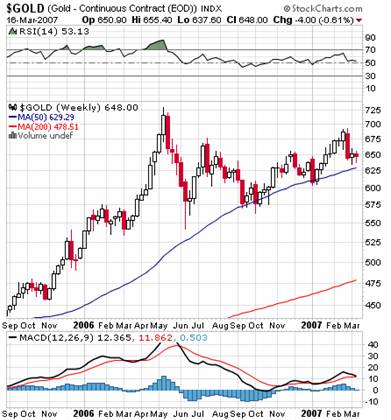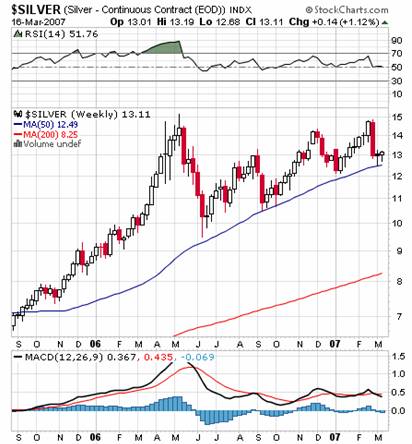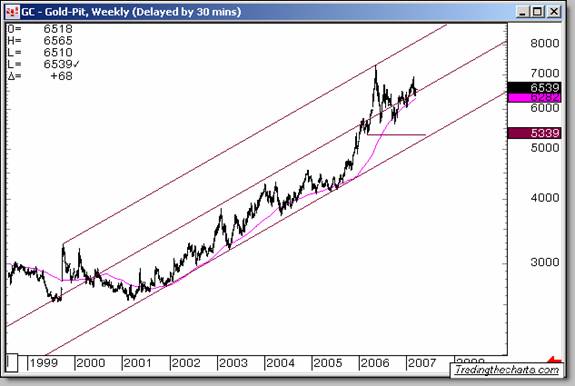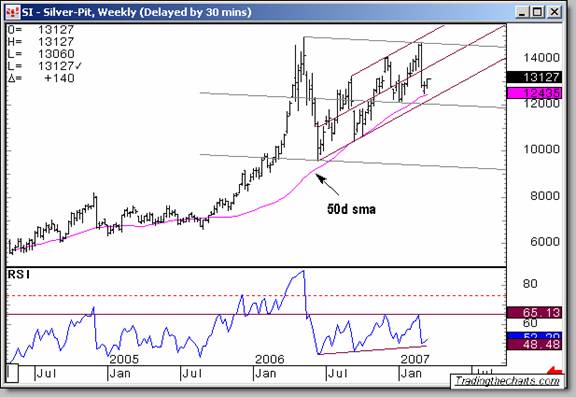Gold and Silver Analysis - Lackluster, But Not Tarnished
Commodities / Gold & Silver Mar 17, 2007 - 09:42 PM GMTBy: Dominick
“Even if there is a retest of support in the next two weeks, vital signs indicate this cat still has plenty of lives.” ~ Precious Points: Nine Lives, March 11, 2007
Though the trading in metals looked pretty unenthusiastic by the end of the week despite higher than expected inflation readings, gold and silver lived up to our expectations and, at Wednesday's lows, landed on all four feet. Readers were directed last week to examine last June, Sept and January on the weekly charts to illustrate the expectation of “inevitable” attempts to retest the 50-day simple moving average at higher lows. Even without the trend charts and commentary available to members of TTC, readers of this weekly update could have reasonably sold early strength and bought near the lows.


These metals could fall all the way to their 200-day moving averages and still be in bull markets. Not only is successfully testing the 50 NOT a dead cat bounce, it's a sign of a rip-snorting bull's bucking and kicking!
The next set of charts, below, confirm the strength at the important support levels just tested, but they also illustrate the precarious nature of this particular juncture. Gold, which has found support at the center trendline of it's upward channel, must now retake it's highs from November and July or risk falling into the lower channel. Despite remaining in its lower channel, silver closed positive for the week and has significant upside north of the early September highs.

(Chart by Dominick)

(Chart by Dominick)
Looking forward in a fundamental context, the only significant economic data next week will be related to housing, Monday's market index, Wednesday's mortgage applications, and Friday's existing home sales. After delivering a prescription for lower bond yields in January, recently filled, last week this update finally contemplated rate cut expectations not to rescue sub-prime, but to encourage well-qualified buyers to ease excess inventories. Indeed, normalizing movement in the yield curve early in the week reflected growing expectation of an easing somewhere between six months and two years out as economic data came in softer than possibly hoped. By Friday's close, however, yields on the long end had receded, despite hot inflation readings in the CPI and PPI, because steady or higher target rates tend to increase real yields.
So, while ongoing weakness in the housing-related credit industry seems to prohibit a rate hike, last week's inflation data all but took rate cuts off the table for at least May. But even when the bond markets were pricing in higher expectations for a rate cut, yields on the 10- and 30-year treasuries fell – regardless of the potentially inflationary repercussions. Analysts believe a reaffirmed hawkish stance from the Fed on Wednesday will keep yields on the long end of the curve low in aid of the housing market, which may prove true, but recent history does not particularly support this view. With home builders still seeing no bottom in sight, and interest rates again trending higher, it does seem, though, that the future of the consumer, the equities markets, and the overall economy are all in the hands of the Federal Reserve.
As the markets prepare for a statement from the Fed next week, there's been plenty of media attention on Alan Greenspan and how his comments on the economy and the sub-prime mortgage market might reflect on the current chairman. There's no guarantee of a “Bernanke rally” on Wednesday, but the markets' recent reactions to Ben's public appearances paint him in an entirely different light from his predecessor. Bernanke's policies, in fact, represent a paradigm shift away from a past where every boom was expected to, and had to be followed by a bust. The wording of Greenspan's now infamous "recession" comments indicate nothing more treacherous than adherence to this older, possibly even outmoded, economic philosophy.
Goldilocks, in contrast, is Bernanke's twenty-first century vision of a brave new world where we can laugh, but not all our laughter, and cry, but not all our tears. The economy, it seems, will not be allowed to grow at an unsustainable pace because of damnable inflation, but it will also avoid the gaping maw of recession through neutral interest rates, abundant liquidity, robust corporate earnings and low taxes. In fact, the Goldilocks economy par excellence is so “just right” that the Fed hardly has to lift a finger, but only lean on occasion one way or another to keep the whole in balance.
There's little or no debate about the policy outcome of this week's meeting, yet the implications are nonetheless staggering. The Fed cannot possible retreat from its inflation vigilance, but the most bullish scenario for stocks would probably downplay or overlook the most recent headline inflation data, which could have adverse effects on metals. In fact, CPI, the Fed's preferred measure, actually showed a sequential decline on Friday. While the Fed is not likely to come to the rescue of the sub-prime market, has very limited ability to do so, and has either way passed the buck to the GSE's, staying the course, in this case, would not at all contraindicate the beginning of a contained inflation, moderate growth scenario that would give the Fed maximum flexibility to lower interest rates without signaling economic weakness.
Because eventually, the Fed will have to move its target rate, even if only in response to foreign central banks – that's the eventuality contemplated by this update since at least last October. A .25 rate hike would most likely come as a result of excessive inflation, only after the housing market has stabilized, and as in 2005, would confirm a bullish environment for metals.
Conversely, a rate cut would probably be confirmation of slow economic growth or even recession, with contained inflation, which in the current environment would be bearish for precious metals in the short term – unless it did not reflect weakness of potentially recessionary proportions. Where intuitively gold would be expected to trade opposite the dollar, it moves in tandem with the greenback when there are issues of liquidity. Where lower interest rates would traditionally imply a lower cost of money, only the housing and credit markets rely on domestic interest rates for liquidity, and liberation from this burden seems to be the ultimate aim of Bernanke's recent “affordable housing” recommendations. In today's global economy it means strain on the yen carry and disincentive to foreign investment.
As the griping about government regulation, the loss of competitiveness, and, most recently, the yen carry trade all suggest, the United States is in the process of losing its economic dominance. And perhaps with this, even the Fed will lose some of its significant influence. Certainly, for metals, selling based on domestic conditions does not consider the prodigious and ongoing demand growth from China and the rest of the emerging economies. Of course that won't prevent next week's housing data from potentially swinging the markets wildly.
In the end, it's not always the facts that determine the market's reaction, but the context. Similarly, a ttempts to anticipate data and the Fed statement for short term trades will probably continue to be frustrating while so much contradiction and uncertainty abounds. The best advice for markets like these is to shut out the noise and trade the charts. It's not just the name of the site, it's the fundamental strategy. And it still just costs $50/month.
by Joe Nicholson (oroborean)
© 2005-2022 http://www.MarketOracle.co.uk - The Market Oracle is a FREE Daily Financial Markets Analysis & Forecasting online publication.



